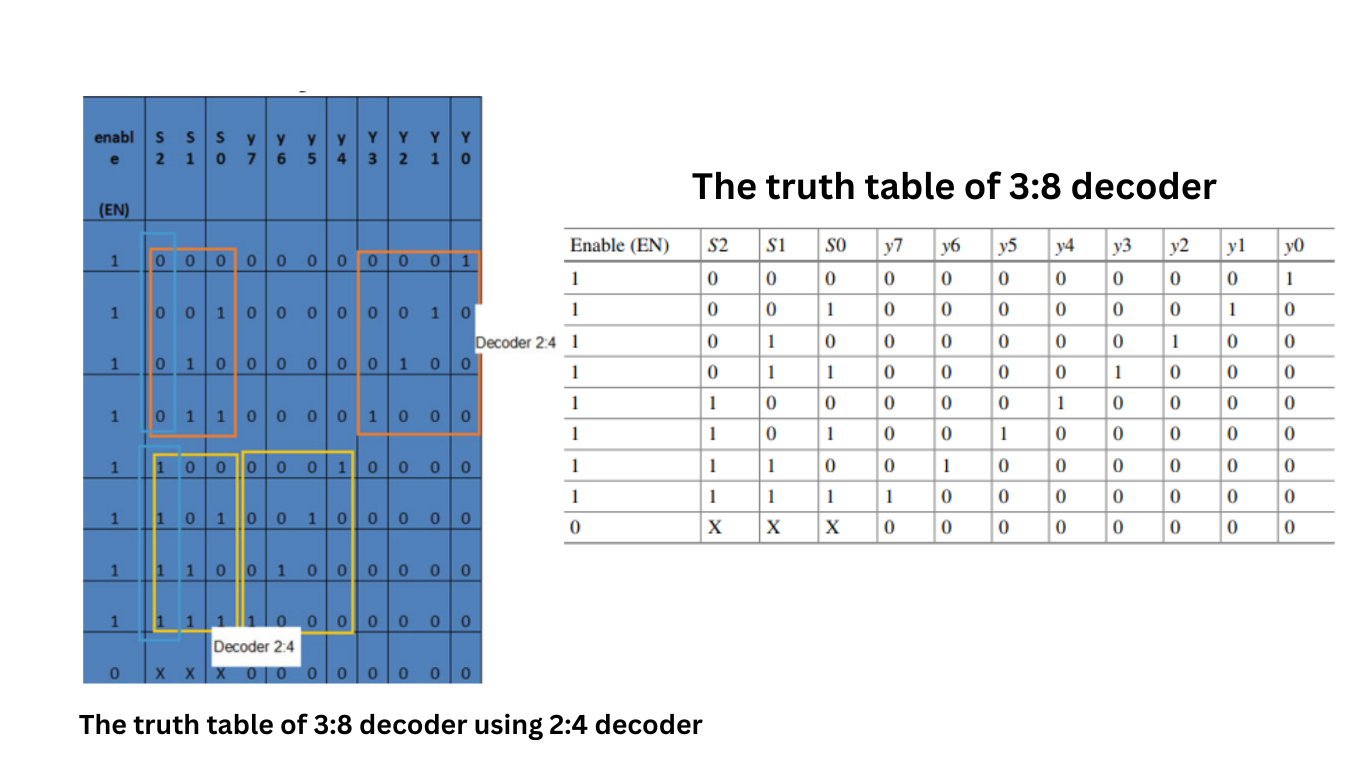
3:8 Decoder
Decoders are digital circuits that convert coded inputs into multiple output lines. They play a vital role in various applications where data needs to be decoded and processed.
To design the 3:8 decoder we need two 2:4 decoders. Why? Because we need to have 8 outputs. The 3:8 decoder has an active high output and active high enables using a minimum number of 2:4 decoders.
From Truth Table, it is clear that the first 2:4 decoder is active for EN = 1 and S2 = 0 and generates outputs y3, y2, y1, and y0. The second 2:4 decoder is active for EN = 1 and S2 = 1 and generates outputs y7, y6, y5, and y4.Both decoders use the select lines as S1 and S0 but the first decoder is enabled for S2 = 0 and the second decoder is enabled for S2 = 1

Decoders Applications
Here are some common types of decoders and their applications:
Binary Decoder: A binary decoder is the simplest form of a decoder, where each input code corresponds to one specific output line. It takes binary input and activates the corresponding output line. Binary decoders find applications in memory address decoding, data demultiplexing, and control signal generation in digital systems.
Demultiplexer (Demux): A demultiplexer is a decoder with additional features that allow it to route a single input to multiple outputs based on a select input. It takes a coded input and directs it to the specified output line based on the select input. Demultiplexers are used in data distribution, signal routing, and memory interfacing.
3-to-8 Decoder: A 3-to-8 decoder has three input lines and eight output lines, where only one output line is active based on the binary input code. It is commonly used in address decoding, memory selection, and data routing applications.
BCD-to-Seven-Segment Decoder: A BCD-to-seven-segment decoder converts Binary Coded Decimal (BCD) input into a seven-segment display output. It is used in digital display systems to convert numeric data into a format that can be shown on a seven-segment display, commonly used in calculators, digital clocks, and panel meters.
BCD-to-Decimal Decoder: A BCD-to-decimal decoder converts Binary Coded Decimal (BCD) input into decimal form. It is employed in BCD arithmetic, where BCD codes need to be converted back to their decimal representation for further calculations or display purposes.
Priority Decoder: A priority decoder is used when multiple inputs are active simultaneously, and the highest-priority input needs to be decoded. It assigns a priority to each input and decodes only the highest-priority active input. Priority decoders are widely used in interrupt handling, data acquisition systems, and priority-based control circuits.
Address Decoder: An address decoder is commonly used in memory systems to select a specific memory location based on the address lines. It takes the address lines as input and activates the corresponding memory chip or location, allowing read or write operations at the desired location.
Instruction Decoder: In microprocessors and digital systems, an instruction decoder is used to decode machine instructions into control signals that direct the execution of operations. It interprets the encoded instructions and generates signals for arithmetic and logic operations, memory access, and control flow.
Decoders are fundamental building blocks in digital circuits and systems, enabling the conversion and processing of encoded data. They provide a means to select specific outputs, route signals, control operations, and interface with various components, contributing to the overall functionality and performance of electronic systems.
Encoders Applications
Encoders are digital circuits that convert multiple inputs into a coded output. They play a important role in various applications where data needs to be encoded and transmitted efficiently.
Here are some common types of encoders and their applications:
Binary Encoder: A binary encoder is the simplest form of an encoder, where the number of output lines is equal to the number of input lines. It converts an n-bit input into a binary code on the output lines. Binary encoders find applications in address decoding, data multiplexing, and control signal generation in digital systems.
Priority Encoder: A priority encoder is used when multiple input lines are active simultaneously, and the highest-priority input needs to be encoded. It assigns a priority to each input and encodes only the highest-priority active input. Priority encoders are widely used in interrupt handling, data acquisition systems, and multiplexers.
Decimal-to-BCD Encoder: A decimal-to-BCD (Binary Coded Decimal) encoder converts a decimal number (0-9) into its corresponding BCD representation. It finds applications in BCD arithmetic, digital displays, and data processing systems that require decimal-to-BCD conversion.
Gray Code Encoder: Gray code encoders are designed to encode binary values into Gray code, where only one-bit changes between adjacent codes. Gray codes are used in applications such as rotary encoders, absolute position encoders, and digital communications systems to prevent errors caused by invalid or ambiguous code transitions.
Absolute Encoder: An absolute encoder provides a unique code for each possible position of a rotating or linearly moving object. It directly translates the object’s position into a digital code without the need for counting or reference points. Absolute encoders are widely used in robotics, CNC machines, and motion control systems.
Rotary Encoder: A rotary encoder is used to measure the position and rotational movement of a shaft or a knob. It generates a digital output signal that corresponds to the direction and amount of rotation. Rotary encoders are commonly found in applications such as volume control knobs, motor control, and robotic joints.
Magnetic Encoder: Magnetic encoders use magnetic fields to measure position or speed. They employ Hall-effect sensors or magnetoresistive sensors to detect changes in the magnetic field caused by the movement of a magnetic target. Magnetic encoders are used in automotive applications, industrial automation, and precision motion control systems.
Quadrature Encoder: A quadrature encoder provides two digital output signals, often referred to as A and B channels, which are 90 degrees out of phase with each other. By monitoring the phase relationship between these signals, the direction and distance of rotation or linear movement can be determined. Quadrature encoders are widely used in robotics, motor control, and positioning systems.
Encoders are essential components in digital systems and automation applications, enabling the efficient encoding and decoding of data. They provide accurate and reliable information for position sensing and signal conditioning. data transmission, and control purposes, contributing to the overall functionality and performance of various electronic systems.